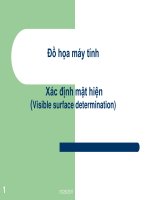Curve and surface (đồ họa máy TÍNH SLIDE)
Bạn đang xem bản rút gọn của tài liệu. Xem và tải ngay bản đầy đủ của tài liệu tại đây (381.67 KB, 29 trang )
Curve and Surface
Outline
• Parametric Curves & Splines
• Cubic Splines
–
–
–
–
Hermite
Bézier
B-Splines
NURBS
• Subdivision Curves & Surfaces
• Appendix: Subdivision Masks
2
How to describe this curve?
3
Control Points
• We can specify control points to draw the curve
4
Control Points
• Control points are not a unique specification
5
Polynomials
• A polynomial is a function of the form:
f(t) = antn + an-1tn-1 + … + a1t + a0
• n is the degree of the polynomial
• The order of the polynomial is the number of
coefficients it has
• Always: order = degree + 1
• Examples:
f(t) = a1t + a0 Linear
f(t) = a2t2 + a1t + a0 Quadratic
f(t) = a3t3 + a2t2 + a1t + a0 Cubic
6
Polynomial Curves
• Could make a curve that passes through n
control points out of a degree (n-1) polynomial
– Regression, Lagrange interpolation, etc.
7
Polynomial Curves
• Polynomial curves wiggle too much when forced
to fit more and more points.
• In technical terms this is called overfitting
8
Why Parametric Curves?
• Parametric curves are very flexible
• They are not required to be functions
• Curves can be multi-valued with respect to any
coordinate system
9
Particle Motion
• A parametric curve P(t) describes the motion of
an imaginary particle through space at time t.
• We can compute the velocity of the particle:
dP(t ) �dx(t ) dy(t ) �
v(t )
�
�
�
dt
dt �
� dt
• The tangent line at P(t0) to the curve is:
tangent(u) = P(t0) + v(t0)u
• The normal at P(t0) perpendicular
(t )the
� dy (t ) dxto
� tangent
�
�
line is n(t0 ) v (t0 ) �
� dt
dt �
t t0
10
Parametric Polynomial Curves
• A parametric polynomial curve is a parametric
curve
n
�
i
x
(
t
)
a
t
• where each function x(t), y(t) �
i
�
i 0
is described by a polynomial: �
�
n
�y (t ) b t i
�
i
�
i 0
�
• Polynomial curves have certain advantages:
– Easy to compute
– Indefinitely differentiable
11
Curve Drawing
• We want:
–
–
–
–
–
Predictable control: Curves don’t wiggle
Multiple values: Curves of arbitrary length
Local control: Local edits have local effects
Versatility: Be able to draw any curve
Continuity: Smoothness guarantees
• Spline curvesgive us all of these
12
Spline Curves
• The word splinecomes from ship building with wood
• A wooden plank is forced between fixed posts,
called “ducks”
• Real-world splines are still being used for designing
ship hulls, automobiles, and aircraft fuselage and
wings
13
Splines
www.abm.org
14
Spline Curves
• Spline curve - any composite curve formed with
piecewise parametric polynomials subject to
certain continuity conditions at the boundary of
the pieces.
– Huh?
• We have seen parametric polynomials. Let’s
look at the other terms:
– Piecewise
– Continuity conditions
15
Piecewise Curves
• To avoid overfitting we will want to represent a
curve as a series of curves pieced together
• A piecewise parametric polynomial curve uses
different polynomial functions for different parts
of the curve
– Advantages: Provides flexibility
– Problem: How do we fit the pieces together?
16
Parametric Continuity
• C0: Curves are joined
– “watertight” curve / mesh
• C1: First derivative is continuous
– d/dt Q(t) = velocity is the same.
– “looks smooth, no facets”
• C2: Second derivative is continuous
– d2/dt2Q(t) = acceleration is
the same (important for animation
and shading)
17
Geometric Continuity
• G0: Curves are joined
• G1: First derivatives are proportional at the joint point
– The tangent vectors have the same directions, but not
necessarily the same magnitude
– Velocity of a moving point is not continuous
• G2: First and second derivatives are proportional at
joint point
– Acceleration of the point is not continuous
• Parametric continuity of order n implies geometric
continuity of order n, but not vice-versa.
18
Specifying Splines
• Control Points - a set of
points that influence the
curve's shape
• Hull - the lines that
connect the control points
• Interpolating – curve
passes through the
control points
• Approximating – control
points merely influence
shape
19
Parametric Cubic Curves
• In order to assure C2 continuity our functions
must be of at least degree three
• Here's what a 2D parametric cubic function looks
like:
• In matrix form:
20
Parametric Cubic Curves
• This is a cubic function in 3D:
• To avoid the dependency on the dimension we
will use the following notation:
21
Parametric Cubic Curves
• What does the derivative of a cubic curve look
like?
22
Solving for Coefficients
• Problem: Polynomial coefficients (the c’s) are
amazingly bad control knobs
• Usually, we want to control the curve in terms of what
it does — passing through control points, etc.
• The whole story of polynomial splines is deriving
their coefficients given a set of control points and
continuity conditions
• Approach:
– State what we want the curve to do
– Solve for coefficients that satisfy the constraints set by the
control points and continuity conditions
23
Outline
• Parametric Curves & Splines
• Cubic Splines
–
–
–
–
Hermite
Bézier
B-Splines
NURBS
• Subdivision Curves & Surfaces
• Appendix: Subdivision Masks
24
Cubic Hermite Specification
• Given:
– Two control points (P1, P2).
– Tangents (derivatives) at the knot points (P’1, P’2):
• “Control knob” vector: [P1, P2, P’1, P’2]
25









